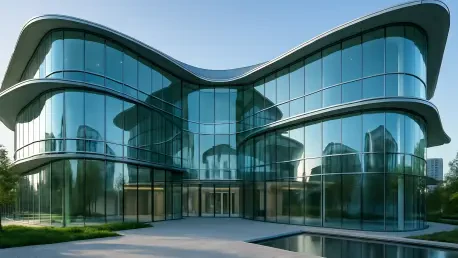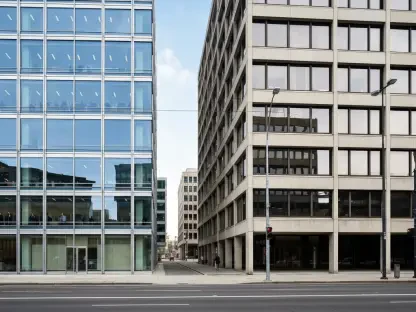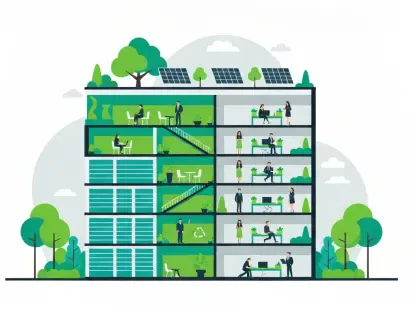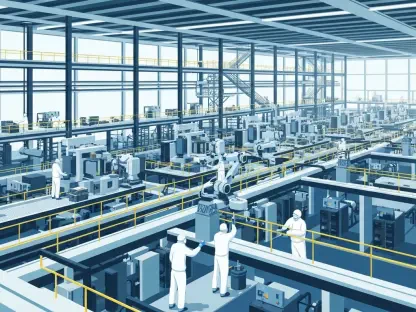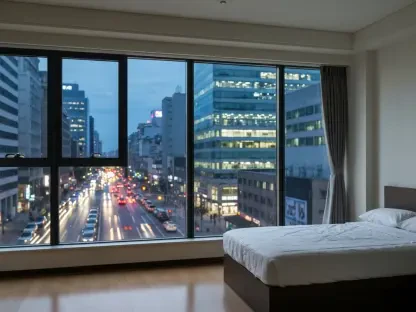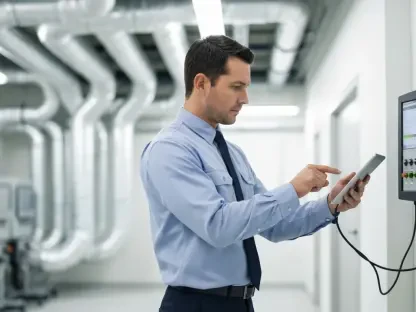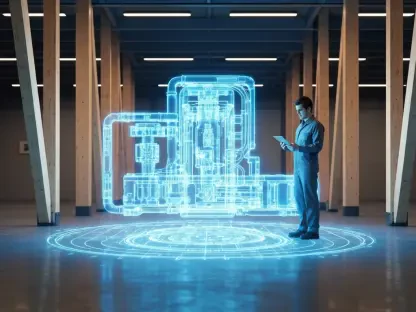Imagine a world where the windows of a skyscraper automatically adjust their tint to block harsh sunlight during the day, then clear up to let in soft evening light, all while cutting energy costs and enhancing comfort for everyone inside. This isn’t science fiction—it’s the reality of smart glass, a groundbreaking technology that can dynamically change its opacity or color in response to environmental shifts or user commands. From cutting-edge airports to tech-savvy corporate campuses, this material is already turning heads in some of the most iconic structures around the globe. Yet, for all its promise, smart glass remains an uncommon sight in everyday buildings like apartment complexes or small offices. The disconnect between its potential and its limited presence raises intriguing questions about innovation, economics, and human behavior in the realm of modern architecture. What exactly is holding back this transformative technology from becoming a staple in construction?
Understanding Smart Glass Technology
Defining the Dynamic Material
Smart glass represents a leap forward in building materials, offering a way to adapt windows to changing conditions with remarkable precision. Unlike traditional glass that remains static, this technology can alter its properties—such as transparency or tint—based on external stimuli like electric currents or sunlight intensity. The concept encompasses several variants, each tailored to specific needs. Electrochromic glass, for instance, gradually darkens or lightens to manage solar heat and glare, making it ideal for energy efficiency in large structures. Suspended particle device (SPD) glass switches almost instantly between clear and opaque states, perfect for privacy applications. Meanwhile, polymer-dispersed liquid crystal (PDLC) glass shifts from transparent to frosted, often used for interior partitions, though it’s less effective at controlling heat. This diversity in function showcases the adaptability of smart glass, positioning it as a versatile tool for architects aiming to balance aesthetics with performance in modern designs.
Mechanisms Behind the Magic
Delving deeper into how smart glass operates reveals a blend of chemistry and engineering that powers its transformative abilities. Electrochromic glass, for example, relies on a thin film of material that changes color when an electric voltage is applied, effectively filtering light and heat over a few minutes. SPD technology uses tiny particles suspended in a film that align under an electric field to allow light through or scatter it for opacity, achieving transitions in mere seconds. PDLC glass, on the other hand, contains liquid crystals that shift orientation with electricity, toggling between clarity and a frosted look for privacy without significantly impacting thermal performance. These mechanisms are often integrated with building management systems to automate adjustments based on time of day or weather conditions. While the science is impressive, it also hints at the complexity of installation and maintenance, factors that play a significant role in the technology’s broader adoption challenges within the construction sector.
Real-World Successes of Smart Glass
Highlighting Iconic Projects
The transformative impact of smart glass shines through in several high-profile projects that demonstrate its practical and aesthetic potential. At San Francisco International Airport’s Terminal 1, electrochromic glass has been deployed to minimize glare and reduce cooling demands, creating a more comfortable environment for travelers while slashing energy costs. Similarly, Google’s Bay View campus in Mountain View incorporates dynamic glazing to enhance sustainability, allowing natural light to flood interiors without the accompanying heat gain. Another striking example is the U.S. Bank Stadium in Minneapolis, where smart glass in the roofline balances daylight with thermal comfort, proving its value in large-scale venues. These installations highlight how the technology can elevate both functionality and design, serving as a testament to its ability to meet modern architectural demands when resources align with ambitious vision.
Beyond Functionality to Inspiration
Beyond their operational benefits, these landmark projects also serve as powerful inspiration for the future of building design with smart glass. The seamless integration at Google’s campus, for instance, not only cuts energy use but also creates a visually striking facade that reflects a commitment to innovation and environmental stewardship. At the Minneapolis stadium, the use of dynamic glazing transforms the spectator experience by maintaining optimal lighting without compromising on comfort, showcasing how technology can enhance human-centric design. Meanwhile, the airport application underscores the scalability of smart glass in high-traffic public spaces, where durability and efficiency are paramount. These cases aren’t just about solving technical problems; they’re about reimagining how buildings interact with their surroundings and occupants. Such examples push the boundaries of what’s possible, even if they remain outliers due to the significant investment required for widespread replication in less prestigious structures.
Barriers to Widespread Adoption
Financial and Practical Hurdles
Despite the allure of smart glass, its path to ubiquity is obstructed by substantial economic and logistical challenges that deter many developers. The upfront cost is a major sticking point—often two to three times that of conventional glass—making it a tough sell for projects with tight budgets. While energy savings from reduced heating and cooling needs are a draw, the payback period can stretch over many years, a timeline that doesn’t always align with the short-term financial goals of property owners. Installation adds another layer of complexity, requiring specialized wiring and integration with building management systems, which can elevate both initial expenses and the risk of technical failures. Maintenance is also a concern, as repairs to these high-tech systems often demand expertise that isn’t readily available, further inflating costs. For midrise apartments or smaller commercial spaces, these practical barriers often outweigh the long-term benefits, keeping traditional glass as the default choice.
User Resistance to Automated Systems
Another significant barrier lies in the human response to smart glass, particularly the automation that defines much of its appeal. Many systems are designed to adjust tint or opacity automatically based on sunlight or temperature, optimizing energy use and comfort without user intervention. However, this loss of personal control can frustrate occupants who prefer to manually manage their environment, whether by drawing blinds or opening windows. The disconnect between technological convenience and individual preference often leads to dissatisfaction, especially in office settings where workers might feel disconnected from their surroundings. This resistance isn’t just anecdotal; it reflects a broader tension in building design where automation must be balanced with user agency. Until smart glass systems can better accommodate personal input—perhaps through intuitive apps or manual overrides—this human factor will remain a subtle yet persistent obstacle to broader acceptance in everyday structures.
Pathways to Greater Acceptance
Innovations Driving Progress
The future of smart glass looks brighter thanks to ongoing technological advancements aimed at addressing its current limitations. Recent developments in electrochromic chemistry have led to faster tint transitions, reducing the wait time from minutes to seconds, while also ensuring more uniform coloring across large panes. Innovations like multifunctional glazing, which combines tinting capabilities with photovoltaic properties to generate electricity, are pushing the boundaries of what this material can achieve. Retrofitting solutions are also emerging, allowing older buildings to adopt smart glass without the need for full window replacements, thus expanding its market reach. Additionally, manufacturers are ramping up production to achieve economies of scale, a move expected to gradually lower costs over the coming years. These strides suggest that technical hurdles, once a major deterrent, are being tackled with ingenuity, paving the way for more accessible and reliable applications in diverse building types.
Policy and Market Influences
Beyond technology, external forces like regulatory frameworks and market trends are poised to accelerate the adoption of smart glass in construction. In regions such as California and New York, stringent energy codes are increasingly mandating high-performance materials to meet sustainability targets, positioning smart glass as a viable solution for compliance. Certifications like LEED and WELL, which emphasize energy efficiency and occupant wellness, further incentivize its use by aligning with broader environmental goals. As these policies tighten, developers may find the long-term benefits of dynamic glazing outweigh initial costs, especially when paired with potential tax incentives or rebates for green building practices. Market demand for sustainable design is also growing, driven by both corporate responsibility and consumer expectations, creating a fertile ground for smart glass to transition from a luxury feature to a practical necessity in new constructions and renovations alike.
The Bigger Picture
Envisioning a Standard in Building Design
Reflecting on the trajectory of smart glass, it becomes clear that this technology holds the potential to evolve from a niche innovation into a fundamental component of future architecture. Much like double glazing or low-emissivity coatings eventually became industry norms, dynamic glazing could redefine building standards if key challenges are addressed. Cost remains the primary barrier, but as production scales and prices drop, its appeal will likely broaden to include more modest projects beyond high-end developments. Reliability must also improve, ensuring that systems perform consistently over time without frequent maintenance issues. Equally important is enhancing user experience, perhaps through customizable controls that restore a sense of agency to occupants. If these pieces fall into place, supported by innovation and policy, smart glass could reshape how structures adapt to environmental and human needs, marking a significant shift toward responsive, sustainable design.
Lessons from a Technology in Transition
Looking back on the journey of smart glass, its story is one of untapped promise tempered by practical constraints that demand resolution. High-profile implementations demonstrate what is achievable when vision and resources align, offering a glimpse of a future where buildings can dynamically respond to their surroundings. Yet, economic realities and user hesitations often stall progress, reminding stakeholders that technology alone isn’t enough without affordability and trust. Advances in performance and manufacturing tackle some of these issues, while regulatory nudges provide momentum for change. The path ahead seems to rest on continued collaboration between innovators, policymakers, and end-users to refine this material’s role in construction. By focusing on scalable solutions and prioritizing occupant engagement, the industry could finally bridge the gap between the potential of smart glass and its presence in everyday architecture, setting a new benchmark for how buildings serve both people and the planet.
